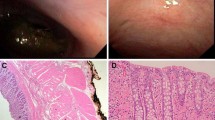Abstract
Background
The incidence of iatrogenic colonic perforation has been gradually increasing. In particular, sigmoid colon perforations are difficult to handle because of excess mobility.
Aim
The aim of this study was to evaluate the efficacy of the twin grasper-clips technique for large perforations of the sigmoid colon.
Methods
This study was designed as a prospective, randomized, experimental study using ex vivo porcine colorectal specimens. Thirty standardized and variable artificial perforations were closed in the hemoclip group (hemoclips) and twin grasper group (hemoclips with a novel tissue grasper). We counted the number of hemoclips used per case to assess the cost and efficacy of the procedure.
Results
In the hemoclip group (n = 15), among the 20-, 25-, and 30-mm defects, the mean number of clips (4.8 ± 0.8, 6.0 ± 1.6, and 8.4 ± 2.1, respectively, p = 0.011) and closure time (7.6 ± 0.5, 9.9 ± 3.3, and 13.9 ± 4.1 min, respectively, p = 0.020) differed significantly. In the twin grasper group (n = 15), among the 20-, 25-, and 30-mm defects, the mean number of clips (4.0 ± 1.0, 5.0 ± 0.7, and 5.4 ± 1.1, respectively, p = 0.101) and closure time (7.7 ± 0.6, 8.3 ± 1.9, and 9.1 ± 2.7 min, respectively, p = 0.506) did not differ significantly. In 30-mm defects, the mean number of hemoclips used per case and total closure time were significantly lower in the twin grasper group than the hemoclip group.
Conclusions
The twin grasper-clips technique seems to reduce the use of hemoclips and to result in more effective and rapid closure than does the conventional technique in large perforations of the ex vivo porcine sigmoid colon.




Similar content being viewed by others
References
Panteris V, Haringsma J, Kuipers EJ. Colonoscopy perforation rate, mechanisms and outcome: from diagnostic to therapeutic colonoscopy. Endoscopy. 2009;41:941–951.
Cobb WS, Heniford BT, Sigmon LB, et al. Colonoscopic perforations: incidence, management, and outcomes. Am Surg. 2004;70:750–757. (discussion 757–758).
Wullstein C, Koppen M, Gross E. Laparoscopic treatment of colonic perforations related to colonoscopy. Surg Endosc. 1999;13:484–487.
Anderson M, Pasha T, Leighton J. Endoscopic perforation of the colon: lessons from a 10-year study. Am J Gastroenterol. 2000;95:3418–3422.
Mana F, De Vogelaere K, Urban D. Iatrogenic perforation of the colon during diagnostic colonoscopy: endoscopic treatment with clips. Gastrointest Endosc. 2001;54:258–259.
Celestino C, Harz C, Decaestecker J, Saenz R. Endoscopic treatment of an iatrogenic perforation of the colon by using endoloop. Gastrointest Endosc. 2006;64:653–654.
Gosen C, Poulose B, Trunzo J, Marks J. Endoscopic management of iatrogenic colon perforation during colonoscopy. Am Surg. 2009;75:184–186.
Raju GS, Saito Y, Matsuda T, Kaltenbach T, Soetikno R. Endoscopic management of colonoscopic perforations (with videos). Gastrointest Endosc. 2011;74:1380–1388.
Levin T, Zhao W, Conell C, et al. Complications of colonoscopy in an integrated health care delivery system. Ann Intern Med. 2006;145:880–886.
Rabeneck L, Paszat LF, Hilsden RJ, et al. Bleeding and perforation after outpatient colonoscopy and their risk factors in usual clinical practice. Gastroenterology. 2008;135:1899–1906, 1906 and 1891.
Singh H, Penfold RB, DeCoster C, et al. Colonoscopy and its complications across a Canadian regional health authority. Gastrointest Endosc. 2009;69:665–671.
Yoshikane H, Hidano H, Sakakibara A, et al. Endoscopic repair by clipping of iatrogenic colonic perforation. Gastrointest Endosc. 1997;46:464–466.
Yang D-H, Byeon J-S, Lee K-H, et al. Is endoscopic closure with clips effective for both diagnostic and therapeutic colonoscopy-associated bowel perforation? Surg Endosc. 2010;24:1177–1185.
Cho SB, Lee WS, Joo YE, et al. Therapeutic options for iatrogenic colon perforation: feasibility of endoscopic clip closure and predictors of the need for early surgery. Surg Endosc. 2012;26:473–479.
Magdeburg RCP, Post S, Kaehler G. Endoclipping of iatrogenic colonic perforation to avoid surgery. Surg Endosc. 2008;22:1500–1504.
Avgerinos DV, Llaguna OH, Lo AY, Leitman IM. Evolving management of colonoscopic perforations. J Gastrointest Surg. 2008;12:1783–1789.
Jovanovic I, Zimmermann L, Fry LC, Mönkemüller K. Feasibility of endoscopic closure of an iatrogenic colon perforation occurring during colonoscopy. Gastrointest Endosc. 2011;73:550–555.
von Renteln D, Schmidt A, Vassiliou MC, Rudolph HU, Gieselmann M, Caca K. Endoscopic closure of large colonic perforations using an over-the-scope clip: a randomized controlled porcine study. Endoscopy. 2009;41:481–486.
von Renteln D, Vassiliou MC, Rothstein RI. Randomized controlled trial comparing endoscopic clips and over-the-scope clips for closure of natural orifice transluminal endoscopic surgery gastrotomies. Endoscopy. 2009;41:1056–1061.
Matthes K, Jung Y, Kato M, Gromski MA, Chuttani R. Efficacy of full-thickness GI perforation closure with a novel over-the-scope clip application device: an animal study. Gastrointest Endosc. 2011;74:1369–1375.
Voermans RP, Le Moine O, von Renteln D, et al. Efficacy of endoscopic closure of acute perforations of the gastrointestinal tract. Clin Gastroenterol Hepatol. 2012;10:603–608.
Baron TH, Song LM, Ross A, Tokar JL, Irani S, Kozarek RA. Use of an over-the-scope clipping device: multicenter retrospective results of the first U.S. experience (with videos). Gastrointest Endosc. 2012;76:202–208.
Katsinelos P, Kountouras J, Chatzimavroudis G, et al. Endoscopic closure of a large iatrogenic rectal perforation using endoloop/clips technique. Acta Gastroenterol Belg. 2009;72:357–359.
Kantsevoy SV, Bitner M, Mitrakov AA, Thuluvath PJ. Endoscopic suturing closure of large mucosal defects after endoscopic submucosal dissection is technically feasible, fast, and eliminates the need for hospitalization (with videos). Gastrointest Endosc. 2014;79:503–507.
Pauli EM, Delaney CP, Champagne B, Stein S, Marks JM. Safety and effectiveness of an endoscopic suturing device in a human colonic treat-and-resect model. Surg Innov. 2013;20:594–599.
Kantsevoy SV, Bitner M, Hajiyeva G, et al. Endoscopic management of colonic perforations: clips versus suturing closure (with videos). Gastrointest Endosc. 2016;84:487–493.
Acknowledgments
This work was supported by the Soonchunhyang University Research Fund.
Author information
Authors and Affiliations
Corresponding author
Ethics declarations
Conflict of interest
None.
Electronic supplementary material
Below is the link to the electronic supplementary material.
Supplementary material 1 (WMV 24107 kb)
Rights and permissions
About this article
Cite this article
Eun, J.Y., Jung, Y., Lee, T.H. et al. The Efficacy of a Novel Tissue Grasper-Clips Technique for Large Perforations of the Sigmoid Colon in an Experimental Animal Model (Video). Dig Dis Sci 62, 913–921 (2017). https://doi.org/10.1007/s10620-017-4483-4
Received:
Accepted:
Published:
Issue Date:
DOI: https://doi.org/10.1007/s10620-017-4483-4




